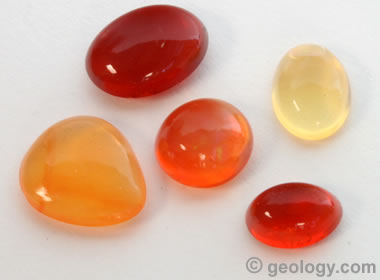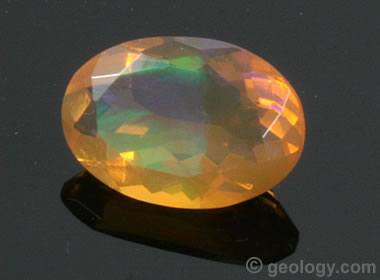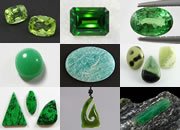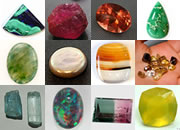Home » Gemstones » Opal » Fire Opal
Fire Opal
Translucent to transparent opal with a fiery background color of yellow, orange, or red.
Author: Hobart M. King, PhD, GIA Graduate Gemologist

Mexican Fire Opal: Cabochons cut from fire opal found in Mexico. They all have a bright red, orange or yellow background color.

Mexican Fire Opal: Some beautiful fire opals from Mexico that have been cut into faceted gems. The red stone measures 9 x 6 mm, the orange stone measures 7 x 6 mm, and the yellow stone measures 8 x 6 mm. Note the difference between these faceted fire opals and the cabochon-cut fire opals above. These faceted gems are transparent, while the cabochon-cut stones are semi-transparent to translucent.
What is Fire Opal?
Many people confuse "fire opal" with "precious opal". So, here is a quick lesson on the three basic types of opal.
- Fire Opal is a variety of opal that has a bright yellow, bright orange or bright red background color. The stones in the first photo on this page are fire opal. They receive their name from their fiery background color.
- Precious Opal is a name given to any opal that exhibits "play-of-color", a flashing display of spectral colors when the opal is "played" under a light source. The second photo on this page shows many varieties of precious opal.
- Common Opal is a variety of opal that does not display "play-of-color" and does not have a background color that would make it a fire opal.
The name "fire opal" is all about the bodycolor - fiery yellow, fiery orange or fiery red. It's not about "flash".
Table of Contents
 Precious Fire Opal Precious Fire Opal How are Fire Opals Cut? How are Fire Opals Cut? Fire Opal Value Fire Opal Value Durability of Fire Opal Durability of Fire Opal Mexican Fire Opal & Other Localities Mexican Fire Opal & Other Localities |

Precious Fire Opal: This is a faceted transparent opal with a light orange bodycolor and a display of greenish and purplish play-of-color. Because of its play-of-color and its orange bodycolor, it could be called a "precious fire opal." It is a 12 x 8 millimeter oval that weighs about 2.2 carats, cut from material mined in Ethiopia.
Precious Fire Opal
A few specimens of fire opal exhibit "play-of-color". These specimens have both the fiery background color of a fire opal and the play-of-color of a precious opal. Some people call these special stones "precious fire opal".
The play-of-color can be tiny bright flashes of color when the opal is played under light, or a billowing glow contained within the stone. The accompanying photo is a precious fire opal cut from material found in Ethiopia. It exhibits a neon green play-of-color from one direction and a neon violet play-of-color from another direction. From a few directions you can see a little of both.
In the past decade, Ethiopia has become a steady producer of beautiful opal. Much of it is yellow to orange semitransparent opals with play-of-color. See our article about Ethiopian Opal.

Faceted Fire Opal: These three stones show the color range of "fire opal," a name given to specimens of opal with a fiery background color. The orange and yellow stones have a sleepy translucence, while the red stone is semitranslucent, almost opaque.
The orange stone is about 7 x 9 millimeters in size and was mined in Oregon. Fire opal of this color is sometimes called "tangerine opal".
The red stone is about 8 x 10 millimeters in size and was mined in Mexico. Fire opal of this color is often called "cherry opal".
The yellow stone is about 9 millimeters across and was mined in Nevada. Fire opal of this color is sometimes called "lemon opal".
How are Fire Opals Cut?
Fire opals are cut in a variety of ways. Some are cut as faceted stones, others are cut as cabochons. The cutter decides how he/she thinks the stone will be most attractive. There is no rule for cutting fire opal.
Transparent fire opals are most often faceted so that they can be illuminated by incident light. If they have a spectacular play-of-color, they might be cut into a cabochon like most precious opal. If the play-of-color is minor, it might be cut into a faceted stone with a little surprise of flash.
Translucent stones are often cut into cabochons, but it is not unusual to see a translucent to nearly opaque fire opal with an attractive color cut into a pretty faceted stone. The three faceted stones in the photo above are wonderful examples of translucent stones that have been faceted.

Cantera Opal: Much of the fire opal found in Mexico is in a rhyolite host rock. It is difficult to remove the opal from the rhyolite without damage. So, some cutters simply cut a cab of rhyolite with a fire opal window in the dome. Cabs with this style of cutting are known as "cantera opal". Many people enjoy them.
Fire Opal Value
The value of a fire opal is based upon the desirability and uniformity of its color, with yellow being on the low end of value and red being on the high end.
Transparent stones are preferred over translucent stones. The best fire opal typically sells for prices that are much lower than the best precious opal; however, fire opal specimens with exceptional color will sell for higher prices than some specimens of precious opal with less impressive play-of-color.
"The defining characteristic of fire opal is the fiery hue of yellow, orange, or red that serves as a background color throughout the stone."
Durability of Fire Opal
Fire opal has a Mohs hardness of 5.5 to 6, which is soft enough that it can be scratched by many objects that it might encounter during everyday wear. Fire opal also has a low tenacity, which means that it can easily be chipped or broken.
Fire opal is best used in jewelry such as earrings, pins, and pendants that usually are not subjected to rough wear. If a fire opal is set into a ring, a setting especially designed to protect the stone from abrasion and impact is recommended.
Mexican and Other Fire Opal Localities
Mexico has been the world's primary source of fire opal for nearly 100 years. The Mexican fire opal deposits produce significant amounts of transparent to translucent, bright orange to orange-red material. Some of the transparent material is faceted, mounted in commercial jewelry, and described as "tangerine opal" because of its color.
In the 1990s, Ethiopia became an important source of opal. Much of the Ethiopian opal is fire opal and precious fire opal. Much of the Ethiopian fire opal is yellow.
Smaller amounts of fire opal are produced in Australia, Brazil, Honduras, and Guatemala. In the United States, Nevada and Oregon produce some beautiful fire opal.
| More Gemstones |
 |
Birthstones |
 |
Diamond |
 |
Blue Gemstones |
 |
100+ Gems |
 |
Green Gemstones |
 |
Mined in America |
 |
Ruby and Sapphire |
 |
Tumbled Stones |

Find Other Topics on Geology.com:

|

| ||

|

| ||

|

| ||

|

|
